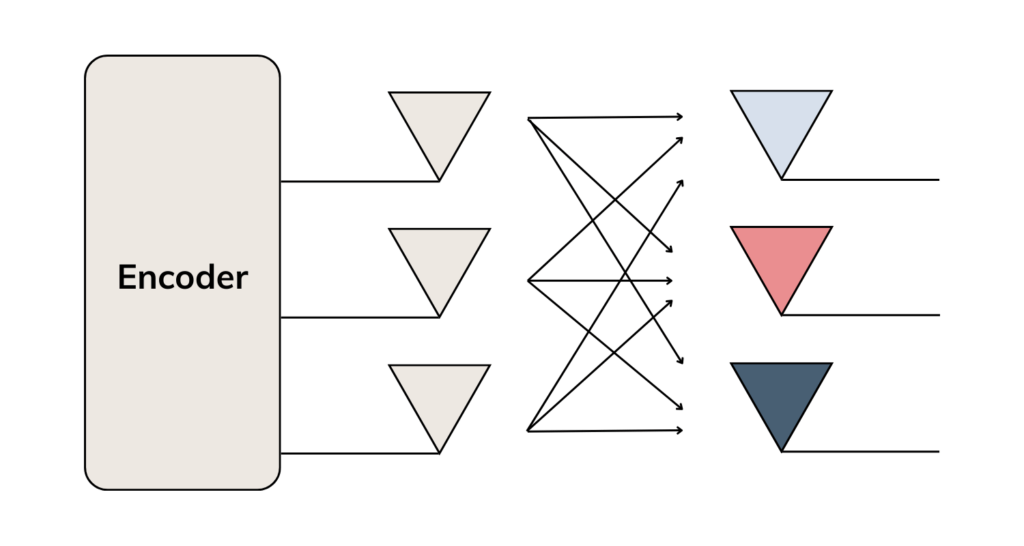Key takeaways from this article:
- MIMO technology enhances data throughput by enabling simultaneous transmission of multiple data streams, and good MIMO antenna design is crucial for optimizing performance without requiring additional spectrum resources.
- MIMO antenna design involves various aspects, including array configuration, beamforming techniques, antenna placement, polarization considerations, radiation patterns, diversity gain, isolation techniques, bandwidth support, and simulations.
- Precise antenna placement is essential to minimize unwanted interference and crosstalk while maximizing the effectiveness of MIMO antenna systems.
In contrast to SISO systems, MIMO systems (Multiple-Input Multiple-Output) enable you to send multiple data streams from a transmitter/sender to a receiver. Through solid MIMO antenna design, you can swap multiple data streams within just a single frequency channel, boosting data throughput without needing extra spectrum resources.
When talking about implementation methods for MIMO, we want to highlight TMD, Spatial Multiplexing, and FDM.
The TMD (Time-Division Multiplexing) method broadcasts data into different channels during specific time intervals. The clear advantage of this method lies in the simplicity of implementation, as well as the fixed time slots. However, there’s a risk of reduced throughput when channels aren’t utilized simultaneously.
TMD can be combined with spatial multiplexing for improved performance. This method utilizes beamforming within subarrays to focus antennas on transmitting or receiving data in specific directions. It’s also used to transmit multiple data streams at the same time.
With spatial multiplexing, you benefit from enhanced throughput and control with directional communication. However, it can be more challenging due to the complexity of beamforming and the need for multiple antennas.
Lastly, we have FDM (Frequency-Division-Multiplexing), which broadcasts multiple data streams over different frequencies in a communication channel. This makes this method very effective for broadcasting different information. But for signal extraction, demultiplexing and filtering are required.

Here’s an illustration of how an antenna array uses beamforming to cater to multiple users: The encoder transmits signals through all the antennas at the same time, tweaking the phase and amplitude for each channel individually. This enables directional data transmission to multiple users, each working on different frequencies.
MIMO Antenna Design
The first step in MIMO design is to configure the antennas. You’ve got a few choices: linear, circular, and planar arrays. These arrays come in two forms: uniform or non-uniform. With a uniform array, the antenna elements are uniformly spaced, while a non-uniform array lets you adjust the spacing to fine-tune how everything performs.
Let’s dive into the concepts of antenna beamforming, placement, and crosstalk.
Beamforming
Beamforming techniques vary in different forms including digital, analog, or hybrid approaches.
Analog beamforming sticks to the tried-and-true phased array setup, using phase-shifting transceivers to manipulate signals.
Digital beamforming simplifies things by managing signal manipulation digitally, which helps in organizing the layout and routing complexities on the PCB.
Lastly, the hybrid approach combines analog and digital techniques, offering a blend of analog broadcasting and digital pre-coding. This hybridization not only reduces the computational load but also simplifies the PCB layout.
Antenna Placement
When it comes to MIMO antenna design, one of the big things to think about is antenna placement. The best placement depends on various factors, like the PCB stack-up, what components you’re using and where they’re placed, your grounding strategy, and how you’re routing everything.
Usually, you’ll want to place the antennas at the edge of the board to maximize separation from digital components. This separation helps keep interference and crosstalk between the antennas and the digital parts to a minimum. Sometimes, especially in complex designs, you might even put some of the digital circuitry on a separate board to keep it even more isolated from the antennas.
Crosstalk
Bad antenna placement can cause unwanted crosstalk issues. Crosstalk happens when antennas transmit signals that interfere with nearby digital channels. It’s like when someone’s playing their music too loud, and it starts bleeding into your room – not cool. This interference can mess with the quality of the signal, causing problems like more jitter and higher levels of noise, which ultimately leads to more errors in your data.
Now, usually, we tend to worry about digital crosstalk into analog channels, but the reverse situation can also be the case. For instance, noise from switching regulators can sneak into the digital channels and mess up the signal integrity.
So, when you’re designing your MIMO antennas, it’s important to consider precise placement and think carefully about all these factors. Getting it right means better performance and less unwanted interference and crosstalk.
Antenna Polarization in MIMO Systems
The use of different polarizations (vertical, horizontal, slant, etc.) can work wonders in reducing interference between antennas. Dual-polarized antennas can effectively double the number of channels in a given space, which ramps up the system’s capacity.
Circular Polarization
CP MIMO (Circular Polarized) antennas are used more in wireless systems, from satellite and mobile communications to global navigation. Unlike their linearly polarized counterparts, CP antennas are less susceptible to polarization mismatch losses, which makes them perfect for long-distance and satellite communications where signal quality is everything.
Enhancing CP Mechanisms
The secret sauce of circular polarization lies in tweaking current distributions and phase shifts. For example, by playing with current directions and phase, you can switch between left-hand circular polarization (LHCP) and right-hand circular polarization (RHCP). This dual capability allows the antenna to efficiently manage polarization diversity, which is crucial for strong and steady wireless links.
Radiation Pattern and Diversity Gain
When it comes to radiation patterns, antennas should be able to broadcast in all directions or focus their signal depending on what they’re used for. For mobile devices, omnidirectional patterns are usually preferred for uniform coverage. And don’t forget to optimize for diversity gain. This is achieved by having uncorrelated or minimally correlated signals at the receiver.
Broadband and Isolation Techniques
First off, there are various ways to cater to the need for wider bandwidths and minimize interference. For instance, by truncating the corners of patch antennas or utilizing dielectric resonator antennas (DRAs) with optimized coupling slots.
Element Spacing
When it comes to spacing between antenna elements, it’s crucial to maintain a distance of at least half the wavelength (λ/2) of the signal to reduce mutual coupling and correlation. However, achieving this in compact devices can be challenging, leading designers to employ decoupling and matching techniques.
Antenna Isolation
Ensuring sufficient isolation between antenna elements is crucial to diminish channel correlation and enhance MIMO performance. This can be achieved through various methods such as electromagnetic bandgap (EBG) structures, parasitic elements, or absorptive materials.
Bandwidth Considerations
In terms of bandwidth considerations, MIMO antenna design must accommodate the required bandwidth for the communication standard. This can be achieved through the design of wideband or multiband antennas, utilizing techniques like fractal shapes, incorporating reactive loading, or employing tunable materials to adapt resonant frequency.
To summarize the article, MIMO systems enable you to send multiple data streams from a transmitter/sender to a receiver. We want to highlight the importance of how precise design choices not only can optimize performance and enhance connectivity – but also make or break your design.
We’ve written an article about MIMO’s counterpart, SISO, in our article ‘Understanding SISO Systems and Control Theory in Practice‘
If you are working with MIMO technology, simulation in the early stages of the process is crucial to predict performance and optimize the design before prototyping. Our AWR solutions can help you to get to where you need to be. Feel free to check them out.
